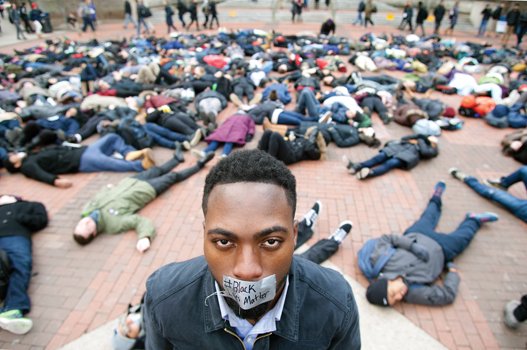#BlackLivesMatter: It’s not your parents’ revolution
Cindy Huang | 1/29/2015, 9:31 p.m.

Black lives matter to Evandra Catherine.
And that means more than fixing a broken criminal justice system.
“Black Lives Matter doesn’t only focus on police brutality. Black lives also matter in systematic things like housing, education, looking for jobs, wages,” said Ms. Catherine, referring to the Black Lives Matter movement, a grassroots network of organizations and community leaders working to improve the lives of black people on all fronts.
Today’s social justice movement — an unpredictable eruption of highly visible demonstrations and “die-ins” of crowds of young people around Richmond’s Downtown and Fan District — is more decentralized and inclusive than the Civil Rights Movement of the 1960s, when Dr. Martin Luther King Jr. led political struggles for equal rights, said Ms. Catherine, a 32-year-old Petersburg resident and participant in the latest wave of actions.
“It’s not a central movement. It’s a movement that touches everyone,” said Ms. Catherine, director of community engagement for Virginia Commonwealth University’s Department of African-American Studies. “Each organization plays their role and makes this movement greater. You don’t have one person standing in the front, like Martin Luther King, saying, ‘This is what needs to happen.’ ”
People from around the country first mobilized around the hashtag #BlackLivesMatter in 2013 after George Zimmerman was acquitted in the killing of unarmed black teenager Trayvon Martin, said Opal Tometi, a co-founder of the Black Lives Matter movement and executive director of Black Alliance for Just Immigration.
“What Black Lives Matter was was a quick and succinct way of saying enough is enough. We’re not going to tolerate it anymore,” said Ms. Tometi, a New York City resident.
The rallying cry was heard again, both online and on the streets, after a white police officer, Darren Wilson, shot and killed unarmed 18-year- old Michael Brown, an African-American, in Ferguson, Mo.
In both cases, Mr. Zimmerman and Mr. Wilson argued that they acted in self-defense.
When a grand jury decided not to indict Mr. Wilson in late November, many people took to social media to express their outrage. They used Twitter, Facebook and other popular social media sites to raise awareness and build a network of activists and action.
For Ms. Catherine, that’s the biggest difference between her parents’ generation of activists and her generation of activists. Information travels a lot faster with social media, picking up the momentum necessary to start a movement, she said.
“Without social media, it would not have received that level of attention,” Ms. Catherine noted.
In cities across the nation, the Black Lives Matter movement has organized strategic and disruptive protests, such as “Black Brunch,” where protesters file into popular restaurants and interrupt diners by reading out the names of people who have been killed by police across the country.
In Richmond, the Black Lives Matter movement is visible both online and on city streets.
After the Missouri grand jury declined to indict Mr. Wilson in Mr. Brown’s death, hundreds of protesters gathered at the John Marshall Courts Building in Richmond’s Downtown and marched to the State Capitol and back. Anyone who wanted to speak could.
Then, after a Staten Island grand jury declined to indict New York police officer Daniel Pantaleo in the chokehold-death of unarmed Eric Garner, Richmond protesters participated in a national “die-in” last December. Dozens of people laid out in the middle of Broad Street, while local police calmly watched, following the crowd and stopping traffic.
Ms. Catherine explained that a “die-in” forces the public to pay attention to the issues by disrupting traffic.
Earlier this month, local activists marched on Martin Luther King Jr. Day and, after speaking during the public comment period, shut down a Richmond City Council meeting with singing, chanting and demands to improve the quality of life for black people in Richmond.
Activist Jamil Jasey, 35, of Richmond marched with about 70 people on Jan. 19 to send a mes- sage to city police: Stop racial profiling.
According to a 2013 Pew Research Center survey, seven in 10 black respondents said African-Americans are treated less fairly than white people in dealing with the police.
But the movement is not just about the criminal justice system. Mr. Jasey said the movement is an inclusive and all-encompassing push for equality and human rights.
“It’s not just a matter of police brutality. It’s a matter of fixing the community,” said Mr. Jasey, who works at a Richmond restaurant.
Ms. Tometi said the movement is stronger when many voices are heard.
“Our movement is decentralized, but it’s organized. We see the benefit in having a movement that is leader-full and not reliant on the talents of one.”
Travis L. Williams, a 32-year-old Richmond resident and activist, said awareness of these problems breaks the illusion that America is a post-racial society.
But the movement is still struggling to communicate its goals to the public, he believes.
“It remains to be seen what the actual product of the movement will be,” Mr. Williams said.
While the Black Lives Matter movement is still in its infancy, said Ms. Catherine, it’s a continuation of the long-waged civil rights struggle for equality.
“My parents are now too old to be involved,” she said. “But they are passing the torch and giving us the opportunity to continue the movement.”








